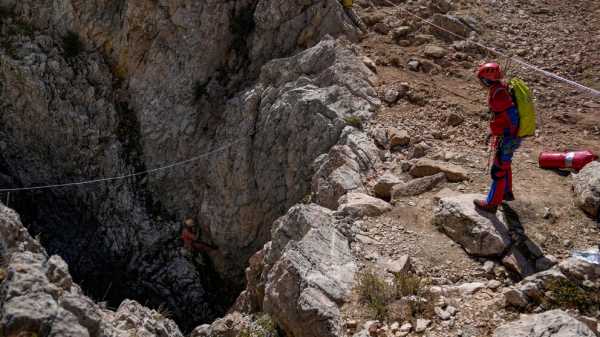
TASELI PLATEAU, Turkey — An American researcher who fell ill almost 1,000 meters (more than 3,000 feet) below the entrance of a cave in Turkey has recovered sufficiently for rescue teams to start the process of moving him out, an operation that could last three or four days, a Turkish official was quoted as saying on Friday.
Mark Dickey, a 40-year-old experienced caver, suddenly became ill with stomach bleeding during an expedition with a handful of others in the Morca cave in southern Turkey’s Taurus Mountains. Rescuers from across Europe have rushed there to help treat Dickey and to extract him from the cave.
“The doctors we sent down were very successful in treating him,” Cenk Yildiz, a regional official from Turkey’s disaster relief agency, AFAD, told the IHA news agency. “We are now in a position to evacuate him.”
“This is a difficult operation. It would take a (healthy) person 16 hours to come out. This operation will last at least three or four days,” Yildiz said. “Our priority is health. Our aim is to conclude this operation without anyone coming under any danger.
Rescuers believe Dickey will have to stop and rest frequently at various points along the way up.
Another Turkish official said rescuers were waiting for doctors to give the go-ahead for the difficult operation to begin.
Recep Salci, the head of AFAD’s search and rescue department, told HaberTurk TV that the plan was to lift Dickey on a stretcher but to use a “security belt” system to lift him through the cave’s narrow openings.
“We are trying to expand the narrow areas by making small explosions, by breaking some areas,” Salci said.
Doctors gave Dickey IV fluids and 4 liters of blood inside the cave, he said. More than 30 rescuers were inside the cave on Friday afternoon, and teams comprised of a doctor and three or four others take turns staying with the American at all times, Salci said.
“Our aim is to bring him out and to have him hospitalized as soon as possible,“ he said.
The European Cave Rescue Association said on its website on Friday that the cave had been divided into seven sections, with various rescue teams taking responsibility for each of the levels down the cave. Communication lines inside the cave had also been improved, it said.
“The doctors are working to further improve the patient’s health’s so that the difficult transport to the surface can begin soon without further complications.”
More than 170 people, including doctors, paramedics and experienced cavers, are involved in the rescue operation.
Members of Italy’s National Alpine and Speleological Rescue Team joined rescue teams from Bulgaria, Croatia, Hungary, Italy, Poland and Turkey late Thursday. A Turkish helicopter was on standby near the entrance of the cave, Turkish media reports said.
The Italian organization said six of their rescuers, including a doctor and nurse, reached Dickey during the night. The team planned to work to keep him stable for 15-20 hours before being replaced by another team.
Small camps set up at different levels inside the cave gave doctors, nurses and technicians a place to rest, the group said.
Turkish authorities made a video message available that showed Dickey standing and moving around on Thursday. While alert and talking, he said he was not “healed on the inside” and needed a lot of help to get out of the cave.
He thanked the caving community and the Turkish government for their efforts to rescue him.
“The caving world is a really tight-knit group ,and it’s amazing to see how many people have responded on the surface,” Dickey said in the video. “I do know that the quick response of the Turkish government to get the medical supplies that I need, in my opinion, saved my life. I was very close to the edge.”
The New Jersey-based cave rescue group that Dickey is affiliated with said he had been bleeding and losing fluid from his stomach but had stopped vomiting and ate for the first time in days. It was not clear what caused the medical issue.
Doctors were expected to decide whether he would need to be taken out on a stretcher or if he can leave under his own power. The New Jersey Initial Response Team said the rescue will require many teams and Dickey will need constant medical attention inside the cave, which is also quite cold.
Dickey was described by the European Association of Cave Rescuers as “a highly trained caver and a cave rescuer himself” who is well known as a cave researcher, or speleologist, from his participation in many international expeditions. He is secretary of the association’s medical committee.
The researcher was on an expedition mapping the 1,276-meter (4,186-foot) deep Morca cave system for the Anatolian Speleology Group Association when he ran into trouble about 1,000 meters down, according to Yusuf Ogrenecek of the Speleological Federation of Turkey. He initially became ill on Sept. 2, but it took until the morning of Sept. 3 to notify others who were above ground.
___
Associated Press writers Suzan Fraser in Ankara, Turkey; Robert Badendieck and Ayse Wieting in Istanbul; Mike Catalini in Trenton, New Jersey; Darko Bandic in Zagreb, Croatia; Justin Spike in Budapest, Hungary; Aritz Parra in Madrid; Monika Scislowska in Warsaw, Poland; Patricia Thomas in Rome and Rhonda Shafner in New York contributed to this report.
Sourse: abcnews.go.com